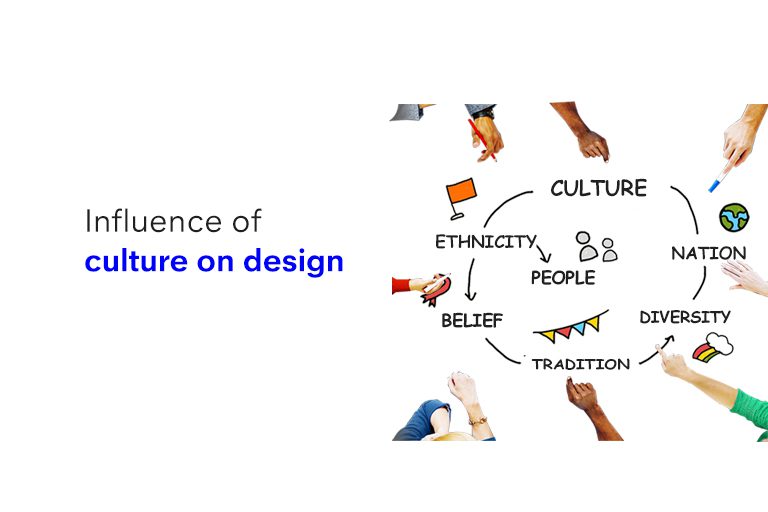Culture is a set of values that are shared amongst a community. These values are customs, art, social behavior, rituals, norms, knowledge, and habits of individuals in a society, essentially they are a way of life. There are a wide number of cultures across the globe that have different associations with color, symbols, language, typography, forms and structures, materials among other things. And because the power culture holds on how a society interprets how they view the various elements of design, culture has been known to influence design for decades. Culture has the power to influence both tangible, i.e. physical aspects and intangible, i.e. software/ digital aspects of design.
These shared sets of values and human experience that form a culture are what inspires and encourages designers to ideate, create and design products and visual communication with more sensitivity to people’s lived experiences. In today’s modern design world, a lot of visual design identity of brands is inspired by the culture around them.
Also Read: A brand identity designer’s guide to responsive logo design
A few design elements that are influenced by culture more than other are:
Color: Cultural influences related to color
Cultural influence connected to color has the ability to affect the perception of a brand. Since they are one of the elements that is a rather eye-catching and visually appealing part of the design, they are registered more deeply with humans. Also, the meaning behind a color can shift from one country to another, one culture to another. For this reason, knowing who you are trying to reach becomes imperative to make the apt choice of colors.
Some very specific colors are also known as universal signs for safety codes, traffic lights, emergency stop buttons, exit signs and warning symbols. Certain products in this regard have always had a color associated with them – School buses have yellow as their designated color, fire extinguishers have red assigned to them and more recently the color green has been associated with our cultural shift towards a more sustainable lifestyle.
Dark red and red, considered as a sign of auspicious cultural festivities, prosperity and celebrations in India and one of the most sought after colors for brides for their wedding outfits, is often associated with death in Africa.
Also Read: Top 5 Inspirational Designers of All Time
Symbols: Cultural influences related to symbols
Symbols are formed using basic lines, circles, numbers, alphabets and shapes. They are written marks, words, images or collective of two or more of the above that have a strong meaning associated with themselves.
With a number of languages across the world, there are plenty of symbols that have strong cultural contexts and some are even religious in nature. Symbols are so strongly ingrained in our systems and lived experiences that one look can help us understand what a brand, advertisement or the design stands for. A religious symbol for one community that represents positivity can mean an entirely different context for people in another country due to their past experiences.
For example, Swastika is a strong symbol of Hinduism representing power, prosperity and good fortune, as well as Mars. However Nazi Party has been known to have adopted the rotated Swastika as their party symbol. Due to this, most Europeans are known to associate Swastika more with the Nazi regime more than with Hinduism.
Symbols are known to take inspiration from nature, flora and fauna, celestial objects among other things. While in some cultures Rats are considered to be holy and are part of zodiac signs and its symbols, in others they hold no such holy place and are rather considered a nuisance and disease spreading animal. From a design perspective, while the community in China may appreciate and consider a visual element of rats as holy in posters or a brand identity, a lot of other countries would never invest in such a product.
Read More: Evolution of creative sketching
Language: Cultural influences connected to language
Language is our tool to communicate with other people and plays a significant role in the design process. While symbols, icons and colors define part of your design, language communicates your story. This is where typography, font style, size and shape also come into picture. Whether it is a packaging design on a product, a visual communication seen digitally or in person via posters, the language you use for your audience is important.
In a country like India, designing packing for a FMCG product involves working with various types of native languages, styled and visually designed in ways that are more appealing to the natives and easy to comprehend, read and make decisions.
When metaphors are translated in different languages, they lose purpose and their charm and are often lost in translation. This is where a designer works with elements of typography to make the communication appear appealing, with relevant information highlighted while making an impact for the brand in consumer’s mind.
Some shopping streets in small towns and cities of Europe are seen to have one common aspect – a similar primary typeface for all their logos and brand identity elements. A strong reason for such similarity may be because European culture has been strongly influenced by large movements in art from classic, medieval, Renaissance, Neoclassical, Romanticism to Modern art. Each movement gave different colors, type styles, symbols and more to the public to work with and some areas seemed to have retained a part of such art movements and inspirations.
Also Read: Innovative Product Design Ideas That Impacted The World
UX design: How culture influences UX design
While the visual elements of color, language and symbols stay the same for the visual appeal in UX, there is also consideration of site navigation and information processing. The way we process information while navigating through any website or app is largely influenced by the culture around us. It defines where we start, what content we pay more attention to and what opinions we form about the content.
It is known that in feminine oriented cultures (Norway, Costa Rica, Sweden and the Netherlands are considered to be feminine culture oriented) have a tendency to prefer/want more links on the landing page as they prefer having various options to make connections between elements. In some cultures, which are more future thinking and pragmatic in approach – it has been found that they interact better with visual content i.e. images, short videos and GIFs.
When it comes to processing the information, research in the past has shown and claimed that there are two distinct manners of thinking, analytical and holistic. The latter is known to be generally associated with Eastern cultures where users prefer to scan through the entire web page before making a decision or forming an opinion, in this manner design requires a neutral background with no distraction – that helps the holistic users and thinker to scan the page.
In analytical culture, primarily western, the focus is on individual information and individual elements and hence calls for a UI design that is more structured. As an example, content that shares the same theme should be grouped in one so that it makes the information easy to process and the analytical thinker and user can process one entire element of information at a time.
Read more: What UX/UI and emerging technologies can do for retail?
Whether you are a freelance designer, working with a large corporation or an entrepreneur with a team, it is always vital to pay attention to small details of your design that are usually connected deeply with the culture of the audience you are targeting.
At Strate School of Design, we help you learn color theory, typography and a focused approach on how to make a brand identity unique, strong and individualistic. You will learn to build culturally relevant products with our various courses, be it Product Design, Brand Identity Design, Interactive Design among others.






Want to Become a Designer ?
Strate is a unique design school that nurtures your talents as a designer by offering state-of-the art designing courses in Bangalore.
Join Strate